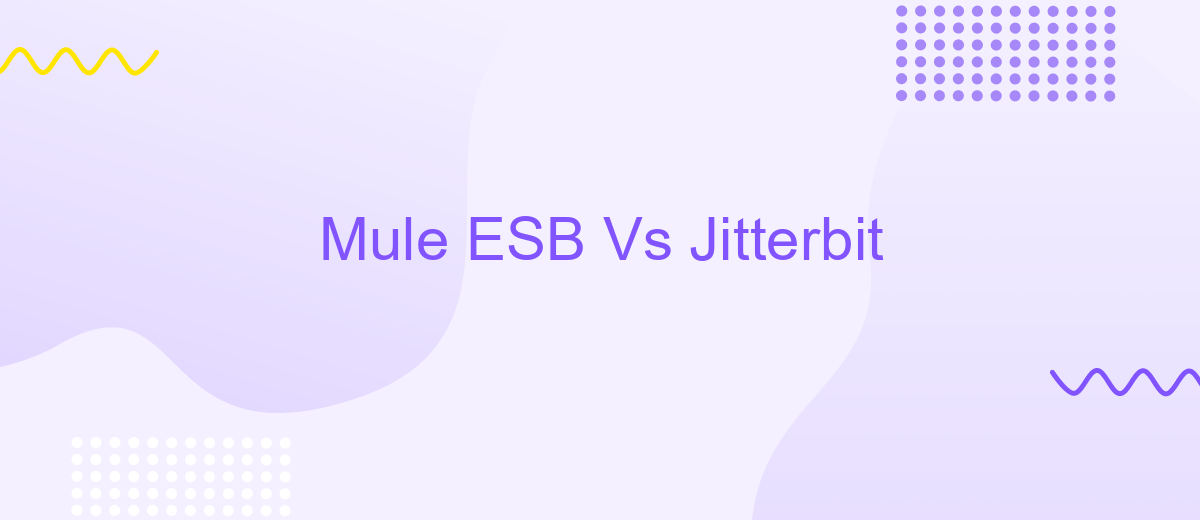Mule ESB Vs Jitterbit
When it comes to integrating diverse systems and applications, choosing the right Enterprise Service Bus (ESB) is crucial. Mule ESB and Jitterbit are two popular options that offer robust integration capabilities. This article provides a comparative analysis of Mule ESB and Jitterbit, examining their features, performance, and usability to help you make an informed decision for your integration needs.
Introduction
In today's rapidly evolving digital landscape, businesses are increasingly relying on integration platforms to streamline their operations and enhance connectivity between various applications. Two prominent players in the integration platform market are Mule ESB and Jitterbit. Both offer robust solutions for connecting disparate systems, but they have distinct features and capabilities that cater to different business needs.
- Mule ESB: Known for its flexibility and scalability, Mule ESB provides comprehensive integration capabilities, making it suitable for large enterprises with complex integration requirements.
- Jitterbit: With a user-friendly interface and rapid deployment, Jitterbit is ideal for small to medium-sized businesses looking for quick and efficient integration solutions.
- ApiX-Drive: A versatile tool that simplifies the integration process, allowing businesses to connect various applications without extensive technical knowledge.
Choosing the right integration platform is crucial for optimizing business processes and ensuring seamless data flow. This article will delve into the key features, advantages, and potential drawbacks of Mule ESB and Jitterbit, helping you make an informed decision based on your specific integration needs.
Features Comparison

Mule ESB and Jitterbit offer robust integration solutions, but they have distinct features that cater to different needs. Mule ESB is known for its strong API management and comprehensive Anypoint Platform, which provides end-to-end integration capabilities. It supports a wide range of protocols and connectors, making it highly versatile for complex enterprise environments. Mule ESB also offers a rich set of tools for API design, development, and analytics, ensuring seamless integration processes and efficient monitoring.
On the other hand, Jitterbit excels in its user-friendly interface and rapid deployment capabilities. It is particularly favored for its intuitive design and ease of use, which allows for quick setup and integration without extensive coding. Jitterbit's Harmony platform provides a unified solution for API integration, data transformation, and workflow automation. Additionally, services like ApiX-Drive can complement Jitterbit by offering pre-built connectors and automation tools, further simplifying the integration process. Both platforms have their unique strengths, making them suitable for different organizational needs and technical requirements.
Pricing and Licensing

When comparing Mule ESB and Jitterbit in terms of pricing and licensing, it's important to note that both platforms offer flexible options to cater to different business needs. MuleSoft provides a subscription-based model with various tiers, including a free community edition for small-scale projects and enterprise editions for larger organizations. Jitterbit, on the other hand, also offers a subscription model with different plans based on the number of integrations and the volume of data processed.
- MuleSoft: Offers a free community edition, and enterprise editions with pricing based on the number of cores and features required.
- Jitterbit: Provides tiered pricing plans, including a free trial and various paid options depending on the complexity and scale of the integration needs.
For businesses looking to streamline their integration processes without extensive technical expertise, services like ApiX-Drive can be beneficial. ApiX-Drive offers a user-friendly platform to set up integrations quickly and efficiently, making it a valuable tool for companies using either Mule ESB or Jitterbit. By leveraging such integration services, businesses can save time and resources while ensuring seamless connectivity between their applications.
Use Cases

Mule ESB and Jitterbit are popular integration platforms, each with specific use cases. Mule ESB is often favored by large enterprises due to its robust architecture and extensive capabilities. It excels in complex integration scenarios, offering high scalability and flexibility for integrating various systems and applications.
On the other hand, Jitterbit is known for its user-friendly interface and rapid deployment capabilities, making it a preferred choice for small to mid-sized businesses. It allows for quick integration of cloud and on-premise applications without extensive coding, which is ideal for businesses looking to streamline their processes efficiently.
- Mule ESB: Suitable for large-scale enterprises needing complex, scalable integrations.
- Jitterbit: Ideal for small to mid-sized businesses requiring quick, user-friendly integrations.
- ApiX-Drive: Perfect for businesses seeking an easy-to-use platform for automating workflows between various services and applications.
Both Mule ESB and Jitterbit offer unique advantages depending on the business size and integration requirements. Platforms like ApiX-Drive can further enhance integration strategies by providing additional automation and ease of use, ensuring seamless connectivity between multiple services.
Conclusion
In conclusion, both Mule ESB and Jitterbit offer robust solutions for integrating various systems and applications. Mule ESB stands out with its strong enterprise capabilities, extensive support for various protocols, and a large community of developers. On the other hand, Jitterbit excels in its ease of use, rapid deployment, and intuitive interface, making it a suitable choice for businesses looking for quick and efficient integration solutions.
When choosing between Mule ESB and Jitterbit, it's essential to consider your specific business needs, technical requirements, and the skill level of your team. Additionally, services like ApiX-Drive can further streamline the integration process by providing pre-built connectors and automation tools, enhancing the efficiency and effectiveness of your integration strategy. Ultimately, the right choice will depend on your organization's unique requirements and long-term goals.
FAQ
What are the primary differences between Mule ESB and Jitterbit?
Which platform is better for complex enterprise integrations?
How do Mule ESB and Jitterbit handle scalability?
What are the licensing and cost considerations for Mule ESB and Jitterbit?
Are there services available to help with the automation and integration setup for these platforms?
Do you want to achieve your goals in business, career and life faster and better? Do it with ApiX-Drive – a tool that will remove a significant part of the routine from workflows and free up additional time to achieve your goals. Test the capabilities of Apix-Drive for free – see for yourself the effectiveness of the tool.

